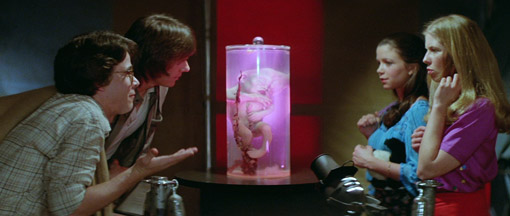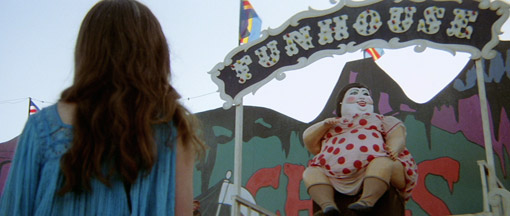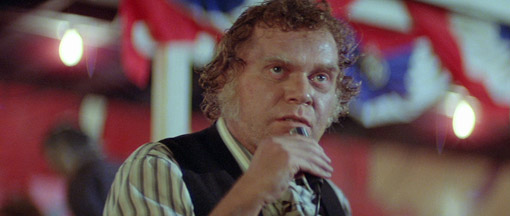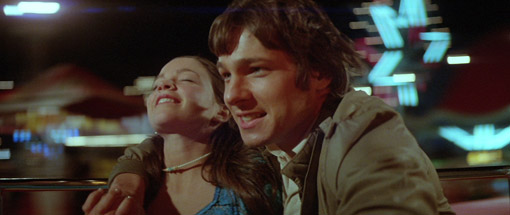|
It would be a particularly prickly horror fan who didn't have a soft spot for independent UK distributor Arrow. It's not just that they release horror films on DVD and Blu-ray – any enterprising label could do that, and a good many do – but that Arrow do it with a touch of love. For the past couple of years they've been working with Cult Laboratories to bring a string of genre favourites from the 70s and 80s, many of which were once banned or censorially mutilated, to DVD and Blu-ray with remastered transfers, fan-targeted extras, and sort of packaging you'll look back on with aching nostalgia should we end up abandoning physical media as a method of home video distribution. I'm not saying they get everything right – we were downright bemused by their attempt to disguise the BBFC imposed cuts on their recent Blu-ray of The New York Ripper by re-editing the scene in question – and the transfers themselves can sometimes vary in quality. But as genre fans we still get just a little bit excited by the prospect of a new Arrow release, though do sometimes get caught in a balancing act between what we hope we'll get and what Arrow, as an independent label with a non-mainstream audience working with sometimes imperfect original material, is able to achieve. When a Blu-ray re-release is promised of our favourite Argento film, for example, we yearn for it to be the definitive edition, one boasting a pristine transfer of an uncut print accompanied by every extra feature you could possibly imagine. But how many releases, independent or mainstream, even come close to matching an expectation like that? The 3-disc Blu-ray of Apocalypse Now is the nearest I've seen this side of the Atlantic, and I don't want to think how much money and manpower that cost to assemble.
But as genre enthusiasts we still like to dream: that horror movies from the 70s and 80s might one day be worthy of the sort of digital restorations lavished on acknowledged classics or big budget studio favourites; that the good people at distributors like Arrow and Shameless might sell enough discs to be able to afford every extra feature that they would like to include; that the BBFC might recognise that the audience for these films is specialised and unlikely to be traumatised by screen violence that no-one would describe as realistic; and that those involved in the original productions might look back fondly on films that helped launch their careers, and be willing to share their recollections instead of shuddering at the memory at ever having had anything to do with a low budget horror movie.

It's with all this buzzing around in my brain that I eagerly approached Arrow's new Blu-ray version of Tobe Hooper's smart 1981 slasher, The Funhouse. It's a film I remember fondly and was so happy to see finally get a DVD release back in 2007 (also courtesy of Arrow), particularly looking as good as it did, that I wasn't in the least bit bothered by the lack of extra features. But the announcement of a Blu-ray upgrade from the very same label can't help but fuel higher expectations for the picture and sound, and the quantity and quality of the extra features.
I've already covered the film itself in my DVD review, which you can read here. Watching it again a couple of years on I still hold it in high regard, although I genuinely wasn't aware until I began watching the extra features here that the film had attracted a more widespread and enthusiastic following. It's one of those films that a close friend and I took to our hearts on our very first viewing, quite aware that others would not share our enthusiasm. Gore hounds complained at the lack of blood and on-screen violence, and a friend I screened it for a few years ago blew loud raspberries at the screen for a good two minutes after the film had concluded. Even the learned and entertaining duo of Calum Waddell and Justin Kerswell (on the below detailed commentary – big spoiler ahead) question the effectiveness of an ending that I still regard as chillingly bleak, as Elizabeth Berridge's emotionally damaged Amy – still is one of the most memorable and convincingly performed Final Girls in modern horror* – wanders tearfully through the carnival in the cold and desolate light of day.
Ironically, perhaps, the very things that some complained about on the film's original release – the lack of explicit violence, the low-key performances, the length of the build-up before the horror kicks off – have given it a longevity that a good many of its genre companions of the period lack. Andrew Laszlo's luminous cinematography and John Beal's grand, carnival-esque score ensure that the film continues to look and sound terrific, and unlike the dweebs in the current crop of 80s horror remakes, the characters here are genuinely likeable and we thus actually give a hoot whether they live or die.
And here's what I meant when I spoke of the mismatch between expectations and results. Arrow's previous DVD of The Funhouse looked damned good for a thirty-year old horror film made on a relatively small budget, and I was thus keen to see how the new Blu-ray would improve on that transfer. Well to be honest, it doesn't, at least not significantly. The level of detail is only slightly superior to that on the DVD, and the rich rendition of the brightly lit colours of the carnival exteriors is close to identical. For the most part the contrast is also very similar, save for the lighter shadow detail in the darker scenes, which also results in a visible increase in grain when the light levels drop. On the best material the transfer still looks very good, but stick it on screen directly alongside the DVD and you'll be pushed to tell the difference.

The film's age may result in some range restrictions (clarity of the mids and trebles, rounded fullness on the bass), but in other respects the DTS-HD Master Audio 2.0 stereo track is an impressive job, being bright, punchy and often very lively, particularly on the music and the the first funhouse ride. Stereo separation is very distinct, making good use of the front sound stage, and there's not a hint of background noise or distortion, even when things get loud. There's just one thing. The Funhouse was one of the first cinema films to have a surround soundtrack, which apparently didn't kick into life until the characters entered the funhouse itself. In the interview on this very disc, director Hooper reveals that he saw the film recently and was struck by how effective this track still is, and it's thus a real shame that it's not present here.
Subtitles for the hearing impaired have been provided on the main feature only.
Here's where this new Blu-ray and the previous DVD release really part company. Dedicated and immensely likeable author, critic and genre enthusiast Calum Waddell was clearly the driving force behind many if not all of the extra features here. Most were produced by High Rising Productions, which Waddell runs with Naomi Holwill and whose house style (which includes distinctive animated opening credits that have the fanboy feel of something produced by a genre enthusiast on After Effects in his or her bedroom) many will recognise from other recent Arrow releases.
Commentary with Calum Waddell & Justin Kerswell
Right at the start of this excellent track, the affable and knowledgeable duo of Callum Waddell and Justin Kerswell, author of the book Teenage Wasteland: The Slasher Movie Uncut, express a quiet dislike for expert genre commentaries, "unless they're done by Alan Jones or Kim Newman," whom they hope to become here the B-movie equivalent of. They've got nothing to worry about, as their busy discussion proves one of the most informative and engaging commentaries I've listened to in years, and one that, as promised by Waddell at the start, avoids over-analysing the movie and instead contextualises it in relation to other 80s horror works and provides a detailed overview of the slasher sub-genre from which it sprang. There is some interesting commentary on the film itself and the process of its production, and a brief discussion on Eli Roth's impending 3D remake, which leads to a debate on poor quality of modern 3D horror movies in general. So enthralling is their conversation that I found myself wanting desperately to be part of it, particularly when Waddell describes the Friday the 13th remake as "one of the biggest pieces of shit I've ever seen," and he could almost be singing the Cine Outsider song when he says, "I lay the blame for everything that's wrong in film with Michael Bay." Excellent stuff.

Commentary with Craig Reardon & Jeffrey Reddick
In a second, equally enthralling commentary, Jeffrey Reddick, creator of the Final Destination film series and a big fan of The Funhouse, plays host to Craig Reardon, the man responsible for executing the make-up effects on the film. As you might expect, the discussion is primarily focussed on Reardon's involvement in the film's production, but is none the worse for that – he's an entertaining storyteller and Reddick knows just when to prompt him or let him talk. And Reardon covers a lot of worthwhile ground, including how he became involved in the production, his first meetings with Rick Baker (both Baker and he were still living with their parents at the time, which gives you an idea of how young these guys started), his fondness for actress Largo Woodruff, his correspondence with special effects makeup god Dick Smith, working with the cast (particularly Wayne Doba, the likeable mime who played the creature), the politics of studio hierarchy, and a good deal more. He has plenty of anecdotes of the shoot and its aftermath, and Reddick contributes a few revealing fanboy memories of being scared or even traumatised by specific scenes.
Commentary with Derek Power and Howard S. Berger
Genre enthusiast Howard S. Berger talks to (and sometimes tries to talk over) Derek Power, who along with Steven Bernhardt produced The Funhouse, and thus has a good few memories of the production to share. Early on he provides a detailed description of the development of the project and his involvement in it, revealing that at one point the film was offered to and accepted by Joe Dante, who had to drop out when an initially uncertain Hooper came back on board (Dante went off to make The Howling, so didn't exactly lose out). He provides plenty of revealing background on the production itself, including the important but uncredited involvement of Jaws editor Verna Fields, and assures us that that the film would never have been finished without the support given to Hooper by director of photography Andrew Laszlo. He bluntly dismisses as "bullshit" the rumour that Hooper did not direct the opening sequence, and is similarly dismissive of some of the stories told about troubles the production had with the Teamsters union, though does worryingly claim that Miami in the early 80s was pretty much how it was portrayed in Scarface. Another fine commentary, this one does thin out about towards the end when the two start watching the movie instead of talking about it, and Berger's genre scholar credits are called into question when he can't remember the surname of Texas Chain Saw lead actress Marilyn Burns.
Trailer (1:28)
A standard early 80s trailer with a beefy voiceover, which hints at plenty but doesn't give too much away.
Carnage at the Carnival (16:25)
A grainy video interview with director Tobe Hooper, who recalls how he was first offered (and was initially unsure of) the film, and provides some worthwhile background on the production itself. He repeats producer Derek Power's claim that cinematographer Andrew Laszlo was sought out because of his work on The Warriors, explains his decision to hold back on the gore, and comments on the effectiveness of the surround soundtrack. Pity we can't hear it, then.

Miles of Mayhem (21:12)
An interview with cheerful and easy-going actor Miles Chapin (he plays smart-alec Richie in the film), who has plenty of stories about his experiences on the production, including working with Largo Woodruff and Wayne Doba, his two-part death scene, having to interpret Hopper's indistinct instructions for his fellow actors, the process of getting himself into terrified mode, and finding The Texas Chainsaw Massacre funny.
The Makeup Madness of Craig Reardon (17:53)
Forthright and engaging effects makeup man Reardon recalls his first experience on a Hooper film (applying makeup to an actress's breasts of Eaten Alive – this is actually an interesting story), landing the job on The Funhouse, working with Wayne Doba, and being hired again by Hooper for Poltergeist.
Masterclass of Horror (12:55)
Horror writer, producer and director Mick Garris (the driving force behind the Masters of Horror series) enthuses about Tobe Hooper and The Funhouse in particular. A passionate and articulate genre devotee, he also provides a detailed and sobering breakdown of the problems he and other filmmakers face trying to make an even half-decent genre movie within the modern studio system.
Tobe Hooper Q&A (20:43)
Preceded by an apology about the picture and sound quality (it was shot from a balcony in low light by a non-professional with the camera in easily fooled autofocus mode – you get the drift), this is a perfect example of why, when it comes to extra features, the quality of content is so much more important than its presentation. Shot on 11th March 2004 at San Francisco's Fearless Tales Film Festival following a double-bill screening of The Texas Chainsaw Massacre Part 2 and Hooper's version of The Toolbox Murders, it consists of highlights from a Q&A with Hooper and the latter film's scriptwriters Jace Anderson and Adam Gierasch, and is moderated by our old friend Calum Waddell. And it's an absolute treat. All three filmmakers talk about remaking one of the odder early entries into the first slasher cycle, Hooper reveals that the first VHS copy he bought of the original Texas Chain Saw was in Harrods in London, and Gierasch admits that he and Anderson "wrote a Jean-Claude Van Damme movie that I would not wish on my worst enemy." (The film was Derailed if you interested in seeing why.) But the meat of the discussion sees all three recall the true-life horrors of filming the 2000 Crocodile on location in the Mexican countryside at night, an increasingly hilarious highlight being Hooper's deadpan memories of trailers covered in tarantulas, crew members floored by scorpions and heart attack, and giant moths that burst into flames when they hit the lights.
Stills Gallery (6:47)
An extra feature we usually end up dismissing is here well executed and interesting, with each still from a rolling gallery of what looks like Craig Reardon's behind-the-scenes photos accompanied by an caption that outlines and expands on the content.
Also included with the release disc (but not the review disc) is a fold-out poster, a booklet with en essay on the film by Kim Newman, and the usual reversible box artwork.
OK, if you're looking to upgrade from the DVD to the Blu-ray on the basis the picture quality alone then you're going to be just a little disappointed, as the visual differences between the two are not that significant. The DTS stereo soundtrack is generally impressive, but the surround track enthusiastically discussed by director Hooper and producer Derek Power is frustratingly absent. But in every other respect this is a cracking disc that fans of the film should still consider an essential purchase for its excellent collection quality special features, which include three first-rate commentaries (there's over four and a half hours worth of often fascinating background info on the film here alone), a number of enthralling interviews, and that hugely entertaining Hooper Q&A – full marks to Arrow for including it in spite of its wobbly technical quality. Thus for all my gripes about what the audio-visual shortcomings – and they are disappointing – this still in many ways showcases Arrow at their horror fanboy best and has to come recommended.
* For the casual or non-horror fans out there, you can read all about Carol J. Clover's Final Girl Theory in her book Men, Women, and Chainsaws: Gender in the Modern Horror Film, or get a concise summary here: http://en.wikipedia.org/wiki/Final_girl.
|